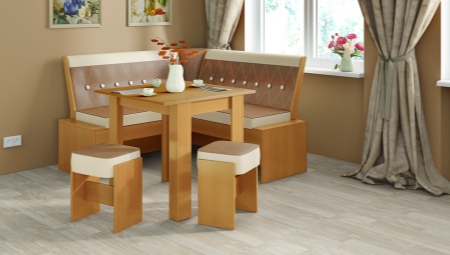Kitchen equipment must be approached thoroughly. Furniture for it should be not only durable, but also aesthetically attractive. Today, one of the key elements in furnishing this room is a bench. In this article we will consider what it can be from the point of view of construction and design, and also note the main nuances of its choice when buying.


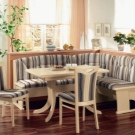

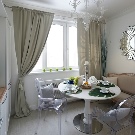
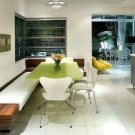
Features
The kitchen bench is a bench for a corner or dining table. In fact, it can be called a kind of alternative to stools and chairs that are used to equip kitchens. Depending on the size of the room and the available furniture, it may differ in size, shape, material of manufacture and degree of practicality.
With the right approach to the selection of this product will contribute to the rational use of the useful area of the kitchen space.
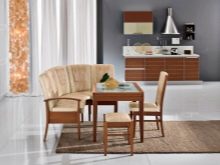
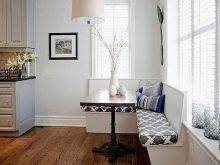
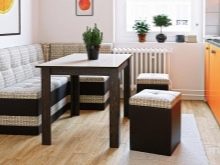
The task of such a shop is to place household members at a table with maximum comfort in a confined area. Based on the variety, the model can be intended to complete the island arrangement of the kitchen, in which each functional corner is designed taking into account zoning techniques. In this case, the bench is a complement to the dining area, consisting of a table and chairs. Depending on the location of the corner, the bench can replace chairs.


It significantly saves usable space and can be designed for a different number of people. This is an improved piece of furniture that has great functionality, since it can be not only a means of placing households and guests at the dining table.
In addition, modern benches, depending on their design and purpose, can be a relaxation area. At the same time, they can be used as narrow sofas.
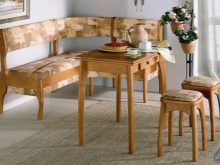

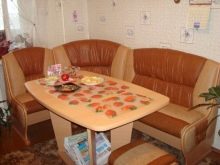
Advantages and disadvantages
Kitchen benches have many advantages. For example, today these products:
- differ in the widest range of stylistics, because of which they can be selected for a specific kitchen design;
- differ in dimensions, which allows you to choose the option taking into account the available usable area of a particular room;
- do not take up much space unlike volumetric chairs with inclined backs;
- in most cases, characterized by comfortable seating, often having a soft upholstery;
- when equipped with capacious boxes, they can be used for additional purposes (storage of dishes, things, packages);
- if there are backs, protect the wall from premature pollution;
- They are distinguished by a wide color gamut, and therefore they are not difficult to choose to match the tone of existing furniture or kitchen accessories;
- made of high quality materials using modern technology;
- can be additionally equipped with soft bedding, increasing the comfort of sitting;
- due to the variety of forms and varieties can be selected not only for typical kitchens, but also for bay windows;
- they are manufactured in a conveyor way in production or in private order to order for specific sizes of kitchen furniture;
- in most cases, leave more room for moving around the kitchen compared to chairs;
- mobile and can be moved to any part of the kitchen at the request of the homeowners;
- differ in price range variability, which allows everyone to choose an option taking into account the budget.


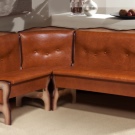


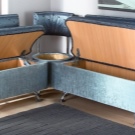
As for the shortcomings, there are not so many of them on kitchen benches. They do not allow the user to stand up without disturbing the people sitting nearby, if the bench is designed for three people. In addition, not all models are convenient for a particular type of kitchen layout. If this is a corner option, it is also difficult to get up from such a bench without disturbing a person sitting nearby.
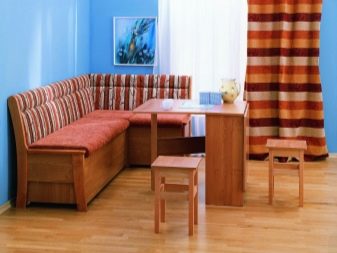
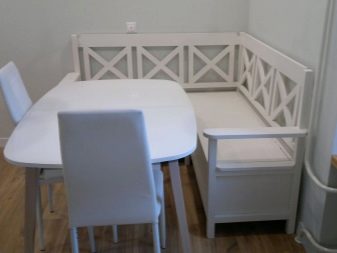
It is worth noting and less convenient cleaning. If it is easier to move stools and chairs when washing the floor, then the legs of the bench will have to be washed without moving the furniture itself. Difficulties can arise when buying, and if the layout provides for the installation of a kitchen bench only in one, not the most convenient place. In this case, it is important to place the shop in the right place so that it does not interfere with households when moving.
The downside of individual models of kitchen benches is the inconvenience of caring for their upholstery. Expensive furniture is beautiful, its upholstery is soft and comfortable, but it needs frequent cleaning, and this leads to its rapid wear.
In addition, not all types of upholstery include cleaning with detergents. Some of them absorb not only pollution, but also unpleasant odors.
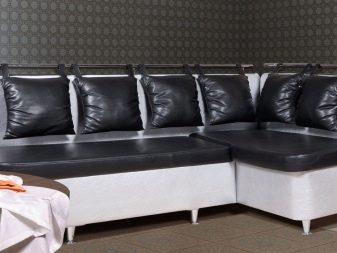

Kinds
Despite the fact that kitchen shops are characterized by varying degrees of user comfort, it’s not difficult to choose a good option. However, for this it is necessary to have an idea of the types of products. Benches for kitchens by type of construction can be linear and angular. Products of the first type are traditional shops, which can be without backs and with them.
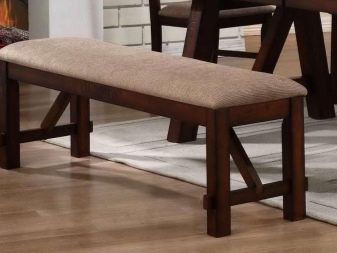
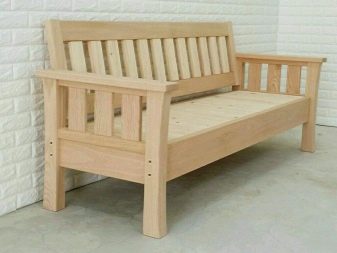
The second modifications are benches with a right angle. They can consist of separate modules standing nearby, or be a single whole. In such models, the side element is fastened between the backs of the bench. Depending on the design and type of construction the side element can be a small connecting part or a full-fledged module of a triangular shape with a smooth fracture of the back.


Products of the second type often look like compact sofas with a berth. These are essentially bench sofas or miniature sofas with straight backswhich are conveniently located against the wall.
Both lines of kitchen benches can have roomy drawers for storing household items, which is important for small kitchens and allows you to remove a lot of little things that create a sense of disorder in a cramped room.


According to the design features of the model of kitchen benches may vary by the presence or absence of legs. Moreover, their number can vary from four for straight (linear) models to 6-11 for analogues of the angular type. The legs of the products can be straight and curved. The products themselves are semicircular and segmental, the seats are straight or with recesses.
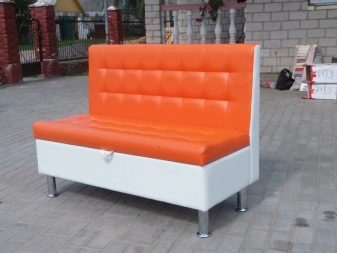
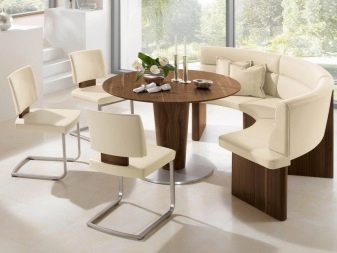
The mechanism for transforming storage systems in kitchen shops can be hinged and retractable. Moreover, the number of internal boxes can be different, depending on the type of product. The backs of kitchen shops are also very diverse. In the simplest form, these are options with a rather rough top. Products of a more pompous appearance are equipped with hinged pillows.
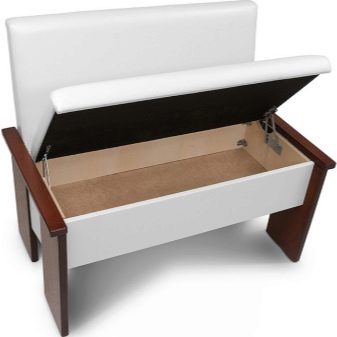

Rarely on sale you can find products of the U-shaped type. Such benches are often made to order, equipping with their help bay window space or gazebos. There can be several boxes for such benches, which depends on the degree of complexity of the structure itself. Another rarity are models equipped not with drawers, but with shelves in which you can place baskets and boxes with the necessary household items.


The difference between some direct models is the transformation mechanism that turns a bench into a compact bed. This is good in cases where it is necessary to have a friend or a lingering guest stay for the night. However, as practice shows, constantly moving such shops is difficult.
Inconvenient in the kitchen and asymmetric modelshaving a curved headboard on one side and providing for the transformation of the shop into a narrow berth.
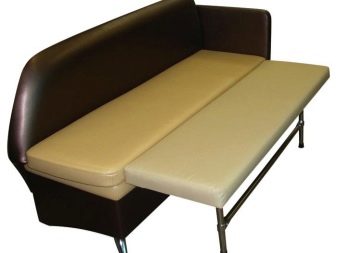

Materials
In the manufacture of kitchen shops use different raw materials. At the same time, producers and buyers are in the greatest demand. wood different breeds and metal. Budget models are made from Particleboard and MDF, as well as plastic. Wooden furniture fits perfectly into the interior of the kitchen, it is practical and durable.
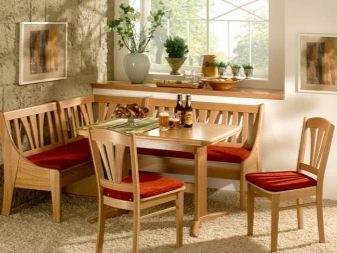
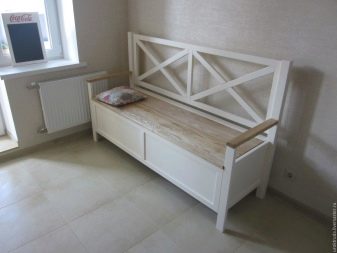
Chrome steel is often used for legs and design elements. Often, she ennobles the design itself, giving it completeness. Metal fits perfectly into modern design areas, such shops suit the styles of hi-tech, brutalism and modern. Wood is used in almost any interior style.
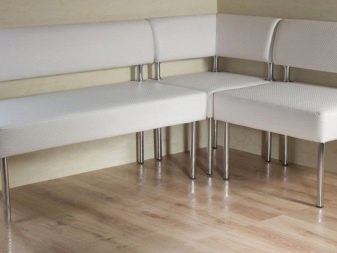
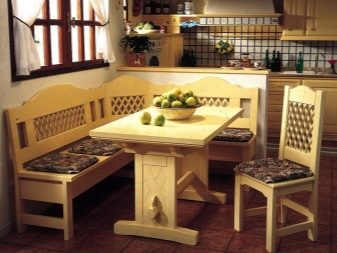
Upholstery material for kitchen benches may be synthetic textiles, artificial and genuine leather, dermatin. Materials such as faux suede, microfiber, flock, tapestry and jacquard have also worked quite well. Foam is used as the basis of soft litter in production.
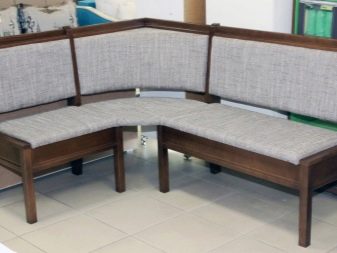
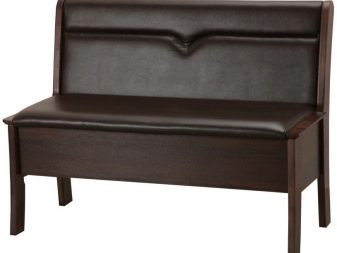
Design
The design solution of the kitchen bench is subject to the specific style of the interior in which the kitchen is designed. Of course, the lining and soft backs, as well as hinged pillows that are mounted on a metal bar, often set the basis for the design. In this case, the pillows can be attached to the hinges. In addition, they can be independent elements of models: unnecessarily, they can be stored inside spacious boxes.
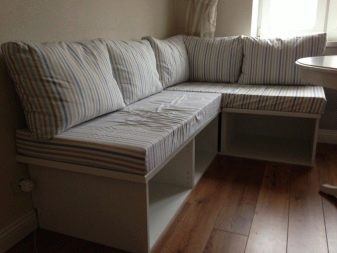
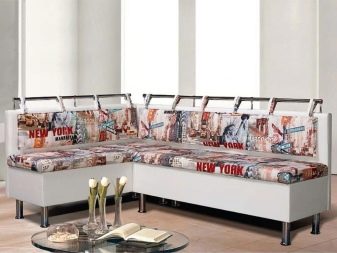
In some cases, pillows are like dense modules, through which you can vary the design of the bench. Sometimes this is a single back cushion with height adjustment. In some cases, the design of the bench is like a quilted mattress, bent from the base to the top of the backs. By the type of design, the backs and seats may not be connected to each other.
Besides, often a design decision involves a model in which the seats can recline separately under each seat. And also the back can be carved, curly, resembling the head of the bed. It can be decorated with a quilted pattern, a print of textile upholstery.Other models allow the use of a mattress and sofa cushions. The bench-chest also looks interesting in the interior.
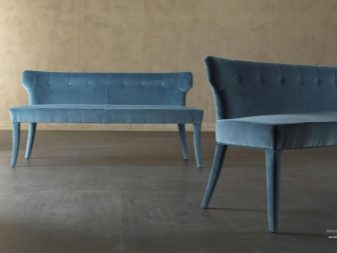

As for color solutions, they are approached from the point of view of practicality. White shop It looks beautiful, but this option is not suitable for a room with an increased likelihood of pollution. It is very easily soiled, in addition, the white color turns yellow over time, which makes the shop untidy. Among the popular tones that buyers are looking for, it is worth highlighting blue, beige, woody, chocolate.
In addition, the following tones are popular: gray-blue, light wenge, lilac metallic, milky, pistachio. Adherents of bright colors look for shops in the shops in contrasts of wine with gray, orange with metallic, indigo with brown and beige. Looks beautiful in the interior of the kitchens of the shop in duets terracotta and mocha, green with white, black with silver and white, brick with gray.


How to choose?
The key rules when buying a kitchen bench There should be factors such as:
- resistance to abrasion;
- reliability of the frame structure;
- low degree of fire;
- environmental friendliness of the material used in the production;
- resistance to absorption of extraneous odors;
- possibility of use when cleaning detergents.
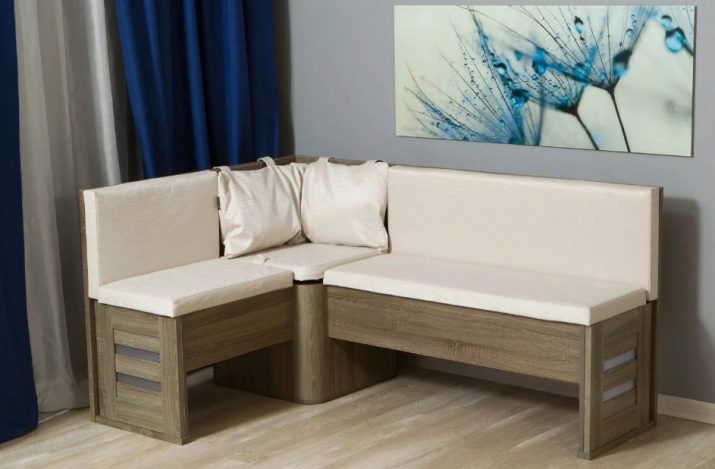
If the store has a product to which you can pick up or order removable covers, it is worth considering as a purchase. For a small kitchenette, you can buy the usual backless benchif the interior of the room seeks simplicity and rural life. For example, this is a great option for styles such as country and shabby chic.
A straight bench with upholstery and a back for more comfort at home. If there is not enough space in the room, the option with armrests is not suitable, but when it is enough, you can consider purchasing a bench-sofa. It can be a narrow model with a retractable or folding transformation system.

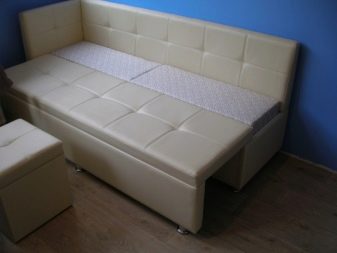
Corner benches look presentable and often decorate the kitchen interior. Often their modules allow you to transform the corner from the left type to the right. However, if the buyer needs a specific model, and the modules cannot be installed properly, this option is not suitable for the arrangement of the kitchen.
To save space in the kitchen, saving it from unnecessary items, you need to take options with capacious drawers. In this case, the models can be semicircular or resembling sofas.
Ideally, if the product has a function for adjusting the legs in height. Even better if the upholstery of the model is made of leather or leatherette.
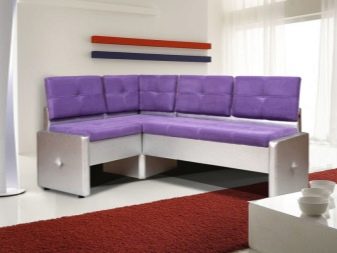

For a tiny kitchen, you can buy a mini bench. If the table in the room is round, you can choose for it a rounded corner model of the kitchen bench, supplementing it with chairs in one design. At the same time, if the table has a glass tabletop, soft silver-colored upholstery will fit it. If the shop has a right angle, it is suitable for a small rectangular table.
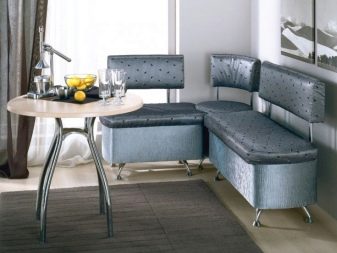
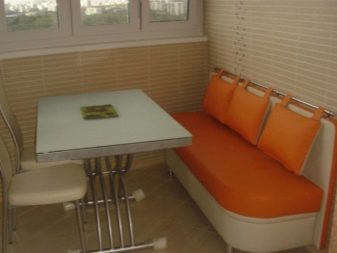
Looking closely at a particular model, it is necessary to rely on the area of the kitchen and the degree of elongation of the room. If it is narrow, it is better to choose the corner option, since the linear bench will lengthen the already narrow room. Between aesthetics and practicality, you need to look for a middle ground. Ideally, if the model is not bulky, but at the same time it will be equipped with at least a small internal box.
For products with soft litter, the filler should be dense, restoring its shape after sitting. Between ordinary foam rubber and polyurethane, you need to choose the second option.
Well, if the model allows the removal of bedding for cleaning. Upholstery material should be practical.

See how to make a bench in the kitchen in the next video.
